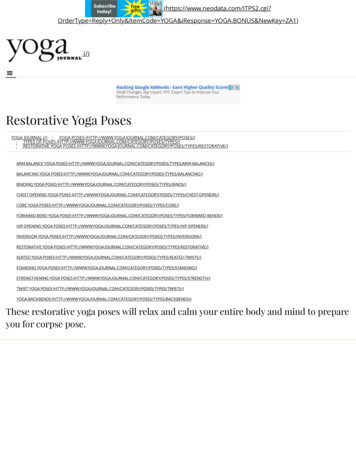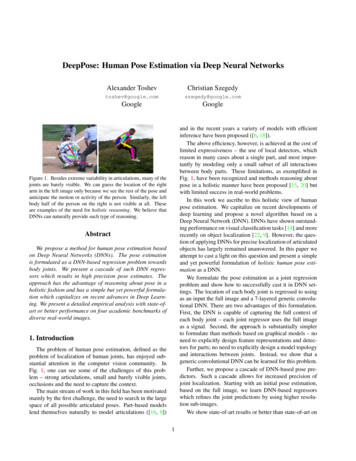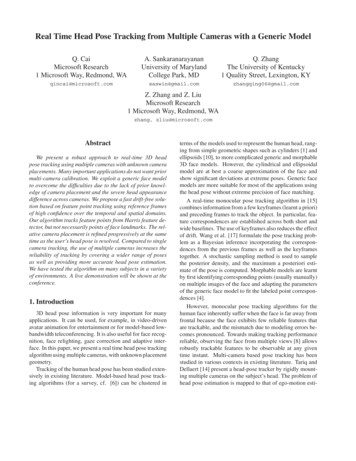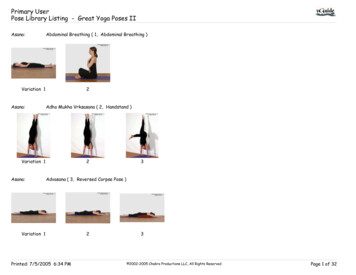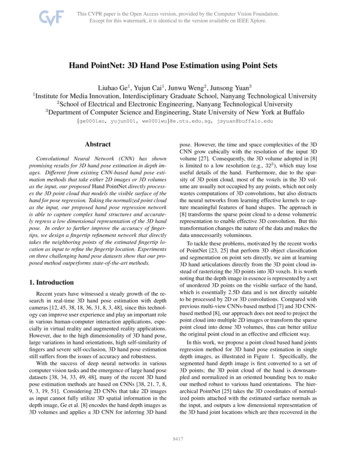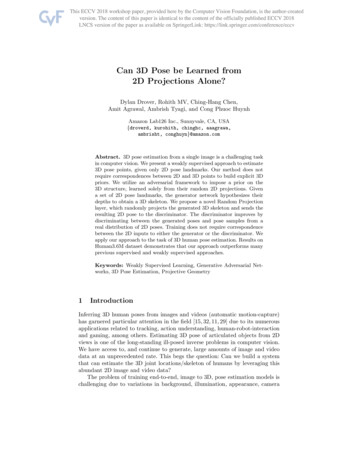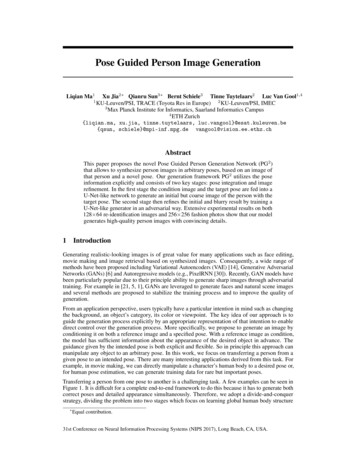
Transcription
Pose Guided Person Image GenerationLiqian Ma1Xu Jia2 Qianru Sun3 Bernt Schiele3 Tinne Tuytelaars2 Luc Van Gool1,4KU-Leuven/PSI, TRACE (Toyota Res in Europe) 2 KU-Leuven/PSI, IMEC3Max Planck Institute for Informatics, Saarland Informatics Campus4ETH Zurich{liqian.ma, xu.jia, tinne.tuytelaars, luc.vangool}@esat.kuleuven.be{qsun, schiele}@mpi-inf.mpg.de vangool@vision.ee.ethz.ch1AbstractThis paper proposes the novel Pose Guided Person Generation Network (PG2 )that allows to synthesize person images in arbitrary poses, based on an image ofthat person and a novel pose. Our generation framework PG2 utilizes the poseinformation explicitly and consists of two key stages: pose integration and imagerefinement. In the first stage the condition image and the target pose are fed into aU-Net-like network to generate an initial but coarse image of the person with thetarget pose. The second stage then refines the initial and blurry result by training aU-Net-like generator in an adversarial way. Extensive experimental results on both128 64 re-identification images and 256 256 fashion photos show that our modelgenerates high-quality person images with convincing details.1IntroductionGenerating realistic-looking images is of great value for many applications such as face editing,movie making and image retrieval based on synthesized images. Consequently, a wide range ofmethods have been proposed including Variational Autoencoders (VAE) [14], Generative AdversarialNetworks (GANs) [6] and Autoregressive models (e.g., PixelRNN [30]). Recently, GAN models havebeen particularly popular due to their principle ability to generate sharp images through adversarialtraining. For example in [21, 5, 1], GANs are leveraged to generate faces and natural scene imagesand several methods are proposed to stabilize the training process and to improve the quality ofgeneration.From an application perspective, users typically have a particular intention in mind such as changingthe background, an object’s category, its color or viewpoint. The key idea of our approach is toguide the generation process explicitly by an appropriate representation of that intention to enabledirect control over the generation process. More specifically, we propose to generate an image byconditioning it on both a reference image and a specified pose. With a reference image as condition,the model has sufficient information about the appearance of the desired object in advance. Theguidance given by the intended pose is both explicit and flexible. So in principle this approach canmanipulate any object to an arbitrary pose. In this work, we focus on transferring a person from agiven pose to an intended pose. There are many interesting applications derived from this task. Forexample, in movie making, we can directly manipulate a character’s human body to a desired pose or,for human pose estimation, we can generate training data for rare but important poses.Transferring a person from one pose to another is a challenging task. A few examples can be seen inFigure 1. It is difficult for a complete end-to-end framework to do this because it has to generate bothcorrect poses and detailed appearance simultaneously. Therefore, we adopt a divide-and-conquerstrategy, dividing the problem into two stages which focus on learning global human body structure Equal contribution.31st Conference on Neural Information Processing Systems (NIPS 2017), Long Beach, CA, USA.
ConditionimageTargetposeTargetimage (GT)CoarseresultRefinedresultConditionimage(a) DeepFashionCondition imageTargetposeTargetimage (GT)CoarseresultRefinedresult(b) Market-1501Target pose sequenceRefined results(c) Generating from a sequence of posesFigure 1: Generated samples on DeepFashion dataset [16] (a)(c) and Market-1501 dataset [37] (b).Our generation sequence (refined results)and appearance details respectively similar to [35, 9, 3, 19]. At stage-I, we explore different ways tomodel pose information. A variant of U-Net is employed to integrate the target pose with the personimage. It outputs a coarse generation result that captures the global structure of the human body inthe target image. A masked L1 loss is proposed to suppress the influence of background changebetween condition image and target image. However, it would generate blurry result due to the use ofL1. At stage-II, a variant of Deep Convolutional GAN (DCGAN) model is used to further refine theinitial generation result. The model learns to fill in more appearance details via adversarial trainingand generates sharper images. Different from the common use of GANs which directly learns togenerate an image from scratch, in this work we train a GAN to generate a difference map betweenthe initial generation result and the target person image. The training converges faster since it is aneasier task. Besides, we add a masked L1 loss to regularize the training of the generator such that itwill not generate an image with many artifacts. Experiments on two dataset, a low-resolution personre-identification dataset and a high-resolution fashion photo dataset, demonstrate the effectiveness ofthe proposed method.Our contribution is three-fold. i) We propose a novel task of conditioning image generation on areference image and an intended pose, whose purpose is to manipulate a person in an image to anarbitrary pose. ii) Several ways are explored to integrate pose information with a person image.A novel mask loss is proposed to encourage the model to focus on transferring the human bodyappearance instead of background information. iii) To address the challenging task of pose transfer,we divide the problem into two stages, with the stage-I focusing on global structure of the humanbody and the stage-II on filling in appearance details based on the first stage result.2Related worksRecently there have been a lot of works on generative image modeling with deep learning techniques.These works fall into two categories. The first line of works follow an unsupervised setting. Onepopular method under this setting is variational autoencoders proposed by Kingma and Welling [14]and Rezende et al. [25], which apply a re-parameterization trick to maximize the lower bound of thedata likelihood. Another branch of methods are autogressive models [28, 30, 29] which compute theproduct of conditional distributions of pixels in a pixel-by-pixel manner as the joint distribution ofpixels in an image. The most popular methods are generative adversarial networks (GAN) [6], whichsimultaneously learn a generator to generate samples and a discriminator to discriminate generatedsamples from real ones. Many works show that GANs can generate sharp images because of using2
concatcoarseresultskip erator at Stage-I (G1)ResUAE (G1) at Stage-IConditionimageRealorFakeReal pairskip connectiondifferencemapDiscriminator (D)at imageFake pairGenerator at Stage-II (G2)Figure 2: The overall framework of our Pose Guided Person Generation Network (PG2 ). It containstwo stages. Stage-I focuses on pose integration and generates an initial result that captures the globalstructure of the human. Stage-II focuses on refining the initial result via adversarial training andgenerates sharper images.the adversarial loss instead of L1 loss. In this work, we also use the adversarial loss in our frameworkin order to generate high-frequency details in images.The second group of works generate images conditioned on either category or attribute labels, texts orimages. Yan et al. [32] proposed a Conditional Variational Autoencoder (CVAE) to achieve attributeconditioned image generation. Mirza and Osindero [18] proposed to condition both generatorand discriminator of GAN on side information to perform category conditioned image generation.Lassner et al. [15] generated full-body people in clothing, by conditioning on the fine-grained bodypart segments. Reed et al. proposed to generate bird image conditioned on text descriptions by addingtextual information to both generator and discriminator [24] and further explored the use of additionallocation, keypoints or segmentation information to generate images [22, 23]. With only these visualcues as condition and in contrast to our explicit condition on the intended pose, the control exertedover the image generation process is still abstract. Several works further conditioned image generationnot only on labels and texts but also on images. Researchers [34, 33, 11, 8] addressed the task of faceimage generation conditioned on a reference image and a specific face viewpoint. Chen et al. [4]tackled the unseen view inference as a tensor completion problem, and use latent factors to imputethe pose in unseen views. Zhao et al. [36] explored generating multi-view cloth images from only asingle view input, which is most similar to our task. However, a wide range of poses is consistentwith any given viewpoint making the conditioning less expressive than in our work. In this work, wemake use of pose information in a more explicit and flexible way, that is, using poses in the formatof keypoints to model diverse human body appearance. It should be noted that instead of doingexpensive pose annotation, we use a state-of-the-art pose estimation approach to obtain the desiredhuman body keypoints.3MethodOur task is to simultaneously transfer the appearance of a person from a given pose to a desired poseand keep important appearance details of the identity. As it is challenging to implement this as anend-to-end model, we propose a two-stage approach to address this task, with each stage focusing onone aspect. For the first stage we propose and analyze several model variants and for the second stagewe use a variant of a conditional DCGAN to fill in more appearance details. The overall frameworkof the proposed Pose Guided Person Generation Network (PG2 ) is shown in Figure 2.3.1Stage-I: Pose integrationAt stage-I, we integrate a conditioning person image IA with a target pose PB to generate a coarseresult IˆB that captures the global structure of the human body in the target image IB .3FConv-ResUAE (G2) at Stage-II
Pose embedding. To avoid expensive annotation of poses, we apply a state-of-the-art pose estimator [2] to obtain approximate human body poses. The pose estimator generates the coordinates of18 keypoints. Using those directly as input to our model would require the model to learn to mapeach keypoint to a position on the human body. Therefore, we encode pose PB as 18 heatmaps. Eachheatmap is filled with 1 in a radius of 4 pixels around the corresponding keypoints and 0 elsewhere(see Figure 3, target pose). We concatenate IA and PB as input to our model. In this way, we candirectly use convolutional layers to integrate the two kinds of information.Generator G1. As generator at stage I, we adopt a U-Net-like architecture [20], i.e., convolutionalautoencoder with skip connections as is shown in Figure 2. Specifically, we first use several stackedconvolutional layers to integrate IA and PB from small local neighborhoods to larger ones sothat appearance information can be integrated and transferred to neighboring body parts. Then, afully connected layer is used such that information between distant body parts can also exchangeinformation. After that, the decoder is composed of a set of stacked convolutional layers which aresymmetric to the encoder to generate an image. The result of the first stage is denoted as IˆB1 . In theU-Net, skip connections between encoder and decoder help propagate image information directlyfrom input to output. In addition, we find that using residual blocks as basic component improves thegeneration performance. In particular we propose to simplify the original residual block [7] and haveonly two consecutive conv-relu inside a residual block.Pose mask loss. To compare the generation IˆB1with the target image IB , we adopt L1 distanceas the generation loss of stage-I. However, sincewe only have a condition image and a targetpose as input, it is difficult for the model togenerate what the background would look like ifthe target image has a different background fromthe condition image. Thus, in order to alleviatethe influence of background changes, we addanother term that adds a pose mask MB to theL1 loss such that the human body is given moreweight than the background. The formulation ofpose mask loss is given in Eq. 1 with denotingthe pixels-wise multiplication:TargetimageTargetposepose keypointsestimationPoseskeletonpose Figure 3: Process of computing the pose mask.LG1 k(G1(IA , PB ) IB )(1 MB )k1 .(1)The pose mask MB is set to 1 for foreground and 0 for background and is computed by connectinghuman body parts and applying a set of morphological operations such that it is able to approximatelycover the whole human body in the target image, see the example in Figure 3.The output of G1 is blurry because the L1 loss encourages the result to be an average of all possiblecases [10]. However, G1 does capture the global structural information specified by the target pose,as shown in Figure 2, as well as other low-frequency information such as the color of clothes. Detailsof body appearance, i.e. the high-frequency information, will be refined at the second stage throughadversarial training.3.2Stage-II: Image refinementSince the model at the first stage has already synthesized an image which is coarse but close tothe target image in pose and basic color, at the second stage, we would like the model to focus ongenerating more details by correcting what is wrong or missing in the initial result. We use a variantof conditional DCGAN [21] as our base model and condition it on the stage-I generation result.Generator G2. Considering that the initial result and the target image are already structurally similar,we propose that the generator G2 at the second stage aims to generate an appearance difference mapthat brings the initial result closer to the target image. The difference map is computed using a U-Netsimilar to the first stage but with the initial result IˆB1 and condition image IA as input instead. Thedifference lies in that the fully-connected layer is removed from the U-Net. This helps to preservemore details from the input because a fully-connected layer compresses a lot of information containedin the input. The use of difference maps speeds up the convergence of model training since the modelfocuses on learning the missing appearance details instead of synthesizing the target image from4
scratch. In particular, the training already starts from a reasonable result. The overall architecture ofG2 can be seen in Figure 2.Discriminator D. In traditional GANs, the discriminator distinguishes between real groundtruthimages and fake generated images (which is generated from random noise). However, in ourconditional network, G2 takes the condition image IA instead of a random noise as input. Therefore,real images are the ones which not only are natural but also satisfy a specific requirement. Otherwise,G2 will be mislead to directly output IA which is natural by itself instead of refining the coarse resultof the first stage IˆB1 . To address this issue, we pair the G2 output with the condition image to makethe discriminator D to recognize the pairs’ fakery, i.e., (IˆB2 , IA ) vs (IB , IA ). This is diagrammed inFigure 2. The pairwise input encourages D to learn the distinction between IˆB2 and IB instead ofonly the distinction between synthesized and natural images.Another difference from traditional GANs is that noise is not necessary anymore since the generator isconditioned on an image IA , which is similar to [17]. Therefore, we have the following loss functionfor the discriminator D and the generator G2 respectively,LD Lbce (D(IA , IB ), 1) Lbce (D(IA , G2(IA , IˆB1 )), 0),(2)advLG Lbce (D(IA , G2(IA , IˆB1 )), 1),(3)advwhere Lbce denotes binary cross-entropy loss. Previous work [10, 17] shows that mixing the adversarial loss with a loss minimizing Lp distance can regularize the image generation process. Herewe use the same masked L1 loss as is used at the first stage such that it pays more attention to theappearance of targeted human body than background,LG2 LG λk(G2(IA , IˆB1 ) IB ) (1 MB )k1 ,(4)advwhere λ is the weight of L1 loss. It controls how close the generation looks like the target image atlow frequencies. When λ is small, the adversarial loss dominates the training and it is more likelyto generate artifacts; when λ is big, the the generator with a basic L1 loss dominates the training,making the whole model generate blurry results2 .In the training process of our DCGAN, we alternatively optimize discriminator D and generator G2.As shown in the left part of Figure 2, generator G2 takes the first stage result and the condition imageas input and aims to refine the image to confuse the discriminator. The discriminator learns to classifythe pair of condition image and the generated image as fake while classifying the pair including thetarget image as real.3.3Network architectureWe summarize the network architecture of the proposed model PG2 . At stage-I, the encoder of G1consists of N residual blocks and one fully-connected layer , where N depends on the size of input.Each residual block consists of two convolution layers with stride 1 followed by one sub-samplingconvolution layer with stride 2 except the last block. At stage-II, the encoder of G2 has a fullyconvolutional architecture including N -2 convolution blocks. Each block consists of two convolutionlayers with stride 1 and one sub-sampling convolution layer with stride 2. Decoders in both G1and G2 are symmetric to corresponding encoders. Besides, there are shortcut connections betweendecoders and encoders, which can be seen in Figure 2. In G1 and G2, no batch normalization ordropout are applied. All convolution layers consist of 3 3 filters and the number of filters areincreased linearly with each block. We apply rectified linear unit (ReLU) to each layer except thefully connected layer and the output convolution layer. For the discriminator, we adopt the samenetwork architecture as DCGAN [21] except the size of the input convolution layer due to differentimage resolutions.4ExperimentsWe evaluate the proposed PG2 network on two person datasets (Market-1501 [37] and DeepFashion [16]), which contain person images with diverse poses. We present quantitative and qualitativeresults for three main aspects of PG2 : different pose embeddings; pose mask loss vs. standard L1loss; and two-stage model vs. one-stage model. We also compare with the most related work [36].2The influence of λ on generation quality is analyzed in supplementary materials.5
4.1DatasetsThe DeepFashion (In-shop Clothes Retrieval Benchmark) dataset [16] consists of 52,712 in-shopclothes images, and 200,000 cross-pose/scale pairs. All images are in high-resolution of 256 256.In the train set, we have 146,680 pairs each of which is composed of two images of the same personbut different poses. We randomly select 12,800 pairs from the test set for testing.We also experiment on a more challenging re-identification dataset Market-1501 [37] containing32,668 images of 1,501 persons captured from six disjoint surveillance cameras. Persons in thisdataset vary in pose, illumination, viewpoint and background, which makes the person generationtask more challenging. All images have size 128 64 and are split into train/test sets of 12,936/19,732following [37]. In the train set, we have 439,420 pairs each of which is composed of two images ofthe same person but different poses. We randomly select 12,800 pairs from the test set for testing.Implementation details On both datasets, we use the Adam [13] optimizer with β1 0.5 andβ2 0.999. The initial learning rate is set to 2e-5. On DeepFashion, we set the number ofconvolution blocks N 6. Models are trained with a minibatch of size 8 for 30k and 20k iterationsrespectively at stage-I and stage-II. On Market-1501, we set the number of convolution blocks N 5.Models are trained with a minibatch of size 16 for 22k and 14k iterations respectively at stage-I andstage-II. For data augmentation, we do left-right flip for both datasets3 .4.2Qualitative resultsAs mentioned above, we investigate three aspects of our proposed PG2 network. Different poseembeddings and losses are compared within stage-I and then we demonstrate the advantage of ourtwo-stage model over a one-stage model.Different pose embeddings. To evaluate our proposed pose embedding method, we implement twoalternative methods. For the first, coordinate embedding (CE), we pass the keypoint coordinatesthrough two fully connected layers and concatenate the embedded feature vector with the imageembedding vector at the bottleneck fully connected layer. For the second, called heatmap embedding(HME), we feed the 18 keypoint heatmaps to an independent encoder and extract the fully connectedlayer feature to concatenate with image embedding vector at the bottleneck fully connected layer.Columns 4, 5 and 6 of Figure 4 show qualitative results of the different pose embedding methodswhen used in stage-I, that is of G1 with CE (G1-CE-L1), with HME (G1-HME-L1) and our G1(G1-L1). All three use standard L1 loss. We can see that G1-L1 is able to synthesize reasonablelooking images that capture the global structure of a person, such as pose and color. However, theother two embedding methods G1-CE-L1 and G1-HME-L1 are quite blurry and the color is wrong.Moreover, results of G1-CE-L1 all get wrong poses. This can be explained by the additional difficultyto map the keypoint coordinates to appropriate image locations making training more challenging.Our proposed pose embedding using 18 channels of pose heatmaps is able to guide the generationprocess effectively, leading to correctly generated poses. Interestingly, G1-L1 can even generatereasonable face details like eyes and mouth, as shown by the DeepFashion samples.Pose mask loss vs. L1 loss. Comparing the results of G1 trained with L1 loss (G1-L1) and G1trained with poseMaskLoss (G1-poseMaskLoss) for the Market-1501 dataset, we find that pose maskloss indeed brings improvement to the performance (columns 6 and 7 in Figure 4). By focusing theimage generation on the human body, the synthesized image gets sharper and the color looks nicer.We can see that for person ID 164, the person’s upper body generated by G1-L1 is more noisy incolor than the one generated by G1-poseMaskLoss. For person ID 23 and 346, the method with posemask loss generates more clear boundaries for shoulder and head. These comparisons validate thatour pose mask loss effectively alleviates the influence of noisy backgrounds and guides the generatorto focus on the pose transfer of the human body. The two losses generate similar results for theDeepFashion samples because the background is much simpler.Two-stage vs. one-stage. In addition, we demonstrate the advantage of our two-stage model overa one-stage model. For this we use G1 as generator but train it in an adversarial way to directlygenerate a new image given a condition image and a target pose as input. This one-stage model isdenoted as G1 D and our full model is denoted as G1 G2 D. From Figure 4, we can see that our fullmodel is able to generate photo-realistic results, which contain more details than the one-stage model.3More details about parameters of the network architecture are given in supplementary materials.6
For example, for DeepFashion samples, more details in the face and the clothes are transferred to thegenerated images. For person ID 245, the shorts on the result of G1 D have lighter color and moreblurry boundary than G1 G2 D. For person ID 346, the two-stage model is able to generate boththe right color and textures for the clothes, while the one-stage model is only able to generate theright color. On Market-1501 samples, the quality of the images generated by both methods decreasesbecause of the more challenging setting. However, the two-stage model is still able to generatebetter results than the one-stage method. We can see that for person ID 53, the stripes on the T-shirtare retained by our full model while the one-stage model can only generate a blue blob as clothes.Besides, we can also clearly see the stool in the woman’s hands (person ID 23).123Condition image Target pose Target (our coarse result)89G1 DG1 G2 D(our refined result)ID. 245ID. 346ID. 116ID. 53ID. 164ID. 23Figure 4: Test results on DeepFashion (upper 3 rows, images are cut for the sake of display) andMarket-1501 dataset (lower 3 rows). We test G1 in two aspects: (1) three pose embedding methods,i.e., coordinate embedding (CE), heatmap embedding (HME) and our pose heatmap concatenationin G1-L1, and (2) two losses, i.e., the proposed poseMaskLoss and the standard L1 loss. Column7, 8 and 9 show the differences among our stage-I (G1), one-stage adversarial model (G1 D) andour two-stage adversarial model (G1 G2 D). Note that all three use poseMaskLoss. The IDs areassigned randomly when splitting the datasets.4.3Quantitative resultsWe also give quantitative results on both datasets. Structural Similarity (SSIM) [31] and the InceptionScore (IS) [26] are adopted to measure the quality of synthesis. Note that in the Market-1501 dataset,condition images and target images may have different background. Since there is no informationin the input about the background in the target image, our method is not able to imagine what the7
Table 1: Quantitative evaluation. For all measures, higher is 1 DG1 G2 22.4552.5082.4552.6823.3103.435Table 2: User study results from AMTDeepFashion4Market-15015ModelR2GG2RR2GG2RG1 DG1 G2 D7.8%9.2%9.3%14.9%17.1%11.2%11.1%5.5%new background looks like. To reduce the influence of background in our evaluation, we proposea variant of SSIM, called mask-SSIM. A pose mask is added to both the synthesis and the targetimage before computing SSIM. In this way we only focus on measuring the synthesis quality of aperson’s appearance. Similarly, we employ mask-IS to eliminate the effect of background. However,it should be noted that image quality does not always correspond to such image similarity metrics.For example, in Figure 4, our full model generates sharper and more photo-realistic results thanG1-poseMaskLoss, but the latter one has a higher SSIM. This is also observed in super-resolutionpapers [12, 27].The advantages are also clearly shown in the numerical scores in Table 1. E.g. the proposed poseembedding (G1-L1) consistently outperforms G1-CE-L1 across all measures and both datasets. G1HME-L1 obtains similar quantitative numbers probably due to the similarity of the two embeddings.Changing the loss from L1 to the proposed poseMaskLoss (G1-poseMaskLoss) consistently improvesfurther across all measures and for both datasets. Adding the discriminator during training eitherafter the first stage (G1 D) or in our full model (G1 G2 D) leads to comparable numbers, eventhough we have observed clear differences in the qualitative results as discussed above. This isexplained by the fact that blurry images often get good SSIM despite being less convincing andphoto-realistic [12, 27].4.4User studyWe perform a user study on Amazon Mechanical Turk (AMT) for both datasets. For each one, weshow 55 real images and 55 generated images in a random order to 30 users. Following [10, 15],each image is shown for 1 second. The first 10 images are used for practice thus are ignored whencomputing scores. From the results reported in Table. 2, we can get some observations that (1)On DeepFashion our generated images of G1 D and G1 G2 D manage to confuse users on 9.3%and 14.9% trials respectively (see G2R), showing the advantage of G1 G2 D over G1 D; (2) OnMarket-1501, the average score of G2R is lower, because the background is much more cluttered thanDeepFashion; (3) On Market-1501, G1 G2 D gets a lower score than G1 D, because G1 G2 Dtransfers more backgrounds from the condition image, which can be figured out in Figure. 4, butin the meantime it brings extra artifacts on backgrounds which lead users to rate ‘Fake’; (4) Withrespect to R2G, we notice that Market-1501 gets clearly high scores ( 10%) because human userssometimes get confused when facing low-quality surveillance images.45R2G means #Real images rated as generated / #Real imagesG2R means #Generated images rated as Real / #Generated images8
ConditionimageTarget image(GT)Ours(refined)VariGAN ge (GT) (coarse)Ours(refined)ID. 215Figure 5: Comparison examples with [36].4.5Figure 6: Our failure cases on DeepFashion.Further analysisID. 2662Since our task with pose condition is novel, there is no direct comparison work. We only comparewith the most related one6 [36], which did multi-view person image synthesis on the DeepFashiondataset. It is noted that [36] used the condition image and an additional word vector of the targetview e.g. “side” as network input. Comparison examples are shown in Figure 5. It is clear thatour refined results are much better than those of [36]. Taking the second row as an example, wecan generate high-quality whole body images conditioned on an upper body while the whole bodysynthesis by [36] only has a rough body shape.Additionally, we give two failure DeepFashion examples by our model in Figure 6. In the top row,only the upper body is generated consistently. The “pieces of legs” is caused by the rare trainingdata for such complicated pos
Pose embedding. To avoid expensive annotation of poses, we apply a state-of-the-art pose estima-tor [2] to obtain approximate human body poses. The pose estimator generates the coordinates of 18 keypoints. Using those directly as input to our model would require the model to learn to map each keypoint to a position on the human body.
